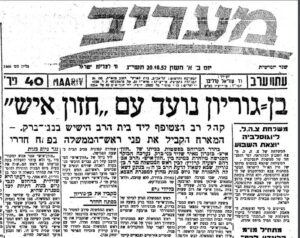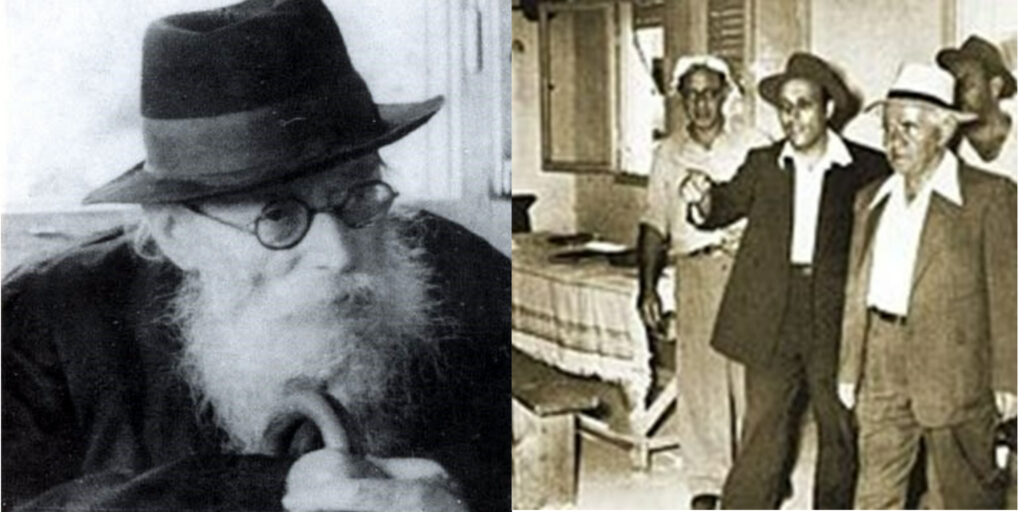Exactly 70 years ago, on Rosh Chodesh Cheshvan in 1952, the talk of the day in Israel centered on the fascinating meeting of the Chazon Ish and Israel’s first prime minister, David Ben-Gurion. The statements during the meeting has been quoted countless times and has been the source of numerous ideological discussions.
What prompted the famous meeting? Ben-Gurion was making great efforts to gather a majority for a bill for national service for girls who were exempted from service in the IDF due to religious reasons. The Chareidi Rabbanim and the Rabbanut expressed strong opposition to the bill and Ben-Gurion realized that if he wanted the support of the Chareidi parties, he would have to gain the support of their leaders.
Since the representatives of the Chareidi party, Poalei Agudas Yisrael (PAGI), often said that they had to consult with the “Chazon Ish,” Ben-Gurion decided that he had to meet this influential leader of Chareidi Jewry.
Ben-Gurion sent his military commander Nechemia Argov to find out if such a meeting could take place. The Chazon Ish responded: “The door is always open.” The meeting was arranged through PAGI representative Binyamin Mintz.
Ben-Gurion, accompanied by his personal secretary [and future Israeli president] Yitzchak Navon, visited the Chazon Ish that evening in his humble Bnei Brak apartment. Close associates had offered to buy the Gadol new furniture in honor of the meeting but he firmly refused.
Navon, who was the only witness to the meeting apart from the Chazon Ish and Ben-Gurion, later wrote: “I too went into the room and sat down in the corner and recorded the conversation. I saw a short Jew, with a handsome face, bent over, a table, a chair, a rickety bed and books, books, books. Everyone thought he would talk to him about the recruitment of girls but there was not one word about that. They sat opposite each other, across a small table.”
Ben-Gurion wrote in his diary later: “I asked him the question to which I have yet to receive a sufficient answer from my observant friends. How will we, religious and non-religious Jews, live (together) without exploding from within? We have different views. How do we live together?”
The Chazon Ish responded: “If two camels meet on a path, and one camel is bearing a load and the other is not bearing a load, the one without a load must give way to the camel bearing a load. We religious Jews are likened to the camel bearing a load – we have a burden of many mitzvos.”
The Chazon Ish provided the nimshal as well, saying: “We, the frum Jews, are carrying the burden of Torah and mitzvos, and the non-religious Zionists, ‘whose wagon is empty’ must step aside for us.”
According to Yitzchak Navon [as quoted by Yediot Achranot], Ben-Gurion then replied: “And on this camel is there no burden of a mitzvah? And the mitzvah of settling the land is not a mitzvah? And is it not a burden? And the mitzvah of protecting life is not a mitzvah? And what are the young men doing that you are so opposed to, and they are sitting on the borders and guarding you, isn’t that a mitzvah?”
Chazon Ish: “They are sustained because we learn Torah.”
Ben-Gurion: “If those young men weren’t protecting you, the enemies would have destroyed you.”
Chazon Ish: “On the contrary, because of our Torah learning, they can live and work and guard.”
The argument between the two continued for a long time, and as Navon described it: “They each maintained their positions and repeated them several times, again and again, without coming closer to each other.”
After they left, Ben-Gurion said: “This is a beautiful, smart Jew with beautiful, smart eyes, [and he is] modest. It’s interesting where his power and influence come from. And how will we live in this country? The ‘ingathering of the exiles’ is not a simple thing. There are many things that can break up our society, but that is the most important question. This is a more serious danger than any external enemy.”
Despite the fact that he apparently did not receive a satisfactory answer to his question, Ben-Gurion was awed by the Chazon Ish. Shortly afterward, he sent him a photo of the two of them, to which he added the caption: “May your honor allow me to add that my visit to him was an unforgettable experience for me.”
Following the meeting, the Prime Minister’s Office issued a statement: “Ben-Gurion met privately with Rabbi A. Y. Karelitz (“The Chazon Ish”) in Bnei Brak yesterday. The purpose of the visit was to exchange general views regarding the following issue: How can observant and non-observant (Jews) live together harmoniously in the State of Israel? The question of recruiting women (to the army) was not discussed and the visit had no relation to current political matters.”
Although the statement clams that question of recruiting women (to the army) was not discussed, there are other versions of the story that tell a different tale.
In חדש אדר -1959, Rabbi Shlomo Lorenzז”ל , a member of Israeli Kenesset, was in Cleveland. During his visit, he spent time with Rabbi Yecheskel Munk and told him the following:
Rabbi Lorenz was a confidant of the חזון איש. The day after the חזון איש met with Ben Gurion, the חזון איש summoned Rabbi Lorenz to come and see him. The חזון איש said to Rabbi Lorenz, as you know yesterday Ben Gurion was here. I am an old man and I want to tell you the complete conversation that we had. I do not want that at any future date they should be able to say that the חזון איש said this or that. One of the things that Rabbi Lorenz said is that the חזון איש told Ben Gurion, that this matter with גיוס נשים , we will win and we are prepared to give up our lives for it. This statement aggravated Ben Gurion and he said, I have a police force and an army to carry out the laws of the land. The חזון איש shook his head, and said, what are you going to do to us? You will take us and tell us that either you send your daughters to the army or you will shoot us.
At that point the חזון איש opened his shirt and said we will stand there and say, SHOOT —- so who won?? (Rabbi Lorenz said that the חזון איש was letting Ben Gurion know clearly that this is יהרוג ואל יעבור and we follow the dictates of the תורה throughout the generations. We proudly forfeited our lives for upholding דבר ה’ and forfeiting our lives for תורה is winning.)
This part of the meeting is also published in the sefer במחיצתם published by Feldheim Volume 1 page 73.

(YWN Israel Desk – Jerusalem)












12 Responses
The general assumption regarding the conversation always was: those who knew didn’t speak and those who spoke didn’t know!
The conversation was in Yiddish and Navon a sfardie didn’t understand a word of it.
If this version of the meeting is correct, than I’m impressed by the apparent civility of the dialogue, notwithstanding the absence of any substantive agreement on the core issue of “widening the road” so that both camels could walk along uninterrupted on parallel paths.
David the Kanoi, you are such an ignorant Jew. By your logic h ow is it possible for for Ashkenazim to speak Hebrew. They only speak Yidddish. Navon spoke many languages, and if you refute this , is it not possible for the CI to speak in the holy language.
“The conversation was in Yiddish” How do you know this?
Only three people were in the room (CI, DBG, Yitzhak Navon) — and only those three know what happened there.
DBG, in his diary, does not mention the camel moshol.
Prof Benny Brown, for his PhD thesis and acclaimed intellectual biography of Chazon Ish, compared the various stories surrounding the meeting and interviewed Navon, who would have been the only person to actually know what was said by either party.
Navon did not confirm CI’s having brought up the camel moshol.
Was Rabbi Shlomo Lorincz was present? He would understand both languages.
Why is this nonsense being written, as if there was a “debate” between the holy Chazon Ish and, liHavdil, this evil Zionist heretic?
If one wants to know what happened in that room, one can read the frum sources that discuss this conversation.
But, sure as day, the Chazon Ish “wiped the floor” with this heretic, even if he did it pleasantly, as divrei chachamim biNachas nishmaim.
From the newspaper article it seems like the Chazon Ish Z”TL was wearing a dark blue silk shirt. That would not have been tolerated in my high school. Wow have the times changed. I’m not blaming anyone, different times call for different rules, regulations and standards. But wouldn’t it be great if we could focus on what’s real again?
P.s. I wonder of it was really Tzitzis with תכלת that he wore tucked in (to avoid financial burden on the ציבור) and that’s why it was silk בדווקה to bring the גמרא of Shatnez to life… I know, a bit far fetched.
“Strength through peace”, the blue silk was a robe, not a shirt. A “chaluk” is a “chalat”.
@Alan – That a Yiddish-speaking, talmid Chachom, “Ashkenazi Jew” should know – understand and speak – Hebrew is not novel in the least. That a Sefardi in Eretz Yisroel 70 years ago should know Yiddish, however, is highly unlikely
@Basesther – Ben Gurion spoke Yiddish fluently.
It has been widely reported that Nobody was allowed in the room with the the Chazon Ish and DBG.
@Basesther Thanx, I stand corrected.